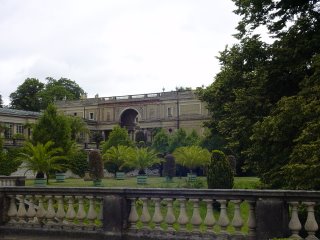The Orangery

The ensuing tour informed me that the place I had found was called the Orangery. Was it used as an orchard at some point? It’s hard to believe, but who knows.

Again they’ve got these over-the-shoes slippers they made me wear. Oddly enough, although the place was much larger and impressive in structure, no king or prince had ever lived there, and thus the interior sculptures and structure were generally less impressive. It did, however, have it’s own odd unity.
Each room’s walls were painted white, but each room had its own separate color theme that every artwork, curtains, and furniture piece followed. Honestly, I thought the whole thing was kind of silly, but each to their own.
The best part of the place though, was a room much taller, wider, and lengthier than the other rooms; it had a museum-like quality to it. Indeed, that was the intent, for the building owner had an expensive collection of copies of works by a famous painter. Now, I’m aware that there are numerous famous painters I’ll be more specific: someone.
I’m afraid I’m writing this from memory, and my memory is failing me. Maybe Rafael? But whoever it was, their talent and notoriety is on par with his. These paintings were clearly meant to be the focus of the room, and certainly they were all the guide mentioned. There were, after all, a huge amount of paintings. But what I appreciated even more were the statues.
Places around the room were statues with a common and interesting theme to them. They all seemed to be of young children interacting in different ways with animals. One sculpture was of a child holding two snakes, another giving a dog water. Yet another statue was of a child feeding a puppy. One statue was of a woman allowing an eagle to perch on her arm, feeding it from her hand. I suspect this was meant to represent a goddess, or someone from mythology. These were not the only statues, but I think you get the idea. I can’t help but wonder if there was a larger unifying theme to these, but if there was, I missed it.
At any rate, after the tour I visited the gift shop. There, I found a map of the entire area. After wandering the garden as long as I had, a map of the area was both refreshing and shockingly informative (though to the reader, perhaps less shocking). The area, for roughly a square mile, was spotted with notable grandiosity. I had seen only the tip of the iceberg, even from the outside I had only happened upon maybe a quarter of what was there. I could have spent a week exploring this garden; it contained more wonderment in a square mile than some countries could aspire to have at all.
This revelation should have struck me with awe, but having spent the time I had investigating it all, to see its true size after all that time seemed somehow chiding, as if the garden had been taunting me all day. See, by this time it was late in the day, of my last day in
Intimidated and defeated, I sulkily walked back down the steps, through the massive courtyard, and embarked on the path back to the San Souci palace – a new path once again, but this one was wide and straight, so I had know doubt as to where it led.

0 Comments:
Post a Comment
<< Home